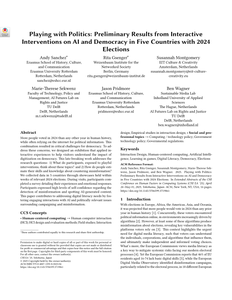In part one of this chapter, I commence by positioning my artistic PhD project in its field of practice (performance, scenography, fine arts), before describing and presenting the variety of methods that I deploy to research, develop and document the questions that I am concerned with. In part two, I zoom in on the case study, Thresholds of Touch, a performative experiment based on an inter-disciplinary collaboration between a composer/researcher, a sociologist and an artist/researcher (myself). I share how we set up a collaborative methodology between social science and artistic research, and what it contributed to researching touch from my perspective on practice-based research. The power relations between disciplines, methods and forms of expression/ knowledge will be traced and discussed. Finally, in the conclusion I reflect on the research outcomes and speculate on how different documentation strategies would have foregrounded other experiences, insights and/or knowledge.
IMAGE

Interactive design is an emerging trend in dementia care environments. This article describes a research project aiming at the design and development of novel spatial objects with narrative attributes that incorporate embedded technology and textiles to support the wellbeing of people living with dementia. In collaboration with people with dementia, this interdisciplinary research project focuses on the question of how innovative spatial objects can be incorporated into dementia long-term care settings, transforming the space into a comforting and playful narrative environment that can enhance self-esteem while also facilitating communication between people living with dementia, family, and staff members. The research methodologies applied are qualitative, including Action Research. Participatory design methods with the experts by experience—the people with dementia—and health professionals have been used to inform the study. Early findings from this research are presented as design solutions comprising a series of spatial object prototypes with embedded technology and textiles. The prototypes were evaluated primarily by researchers, health professionals, academics, and design practitioners in terms of functionality, aesthetics, and their potential to stimulate engagement. The research is ongoing, and the aim is to evaluate the prototypes by using ethnographic and sensory ethnography methods and, consequently, further develop them through co-design workshops with people living with dementia.
MULTIFILE

More people voted in 2024 than any other year in human history, while often relying on the internet for political information. This combination resulted in critical challenges for democracy. To address these concerns, we designed an exhibition that applied interactive experiences to help visitors understand the impact of digitization on democracy. This late-breaking work addresses the research questions: 1) What do participants, exposed to playful interventions, think about these topics? and 2) How do people estimate their skills and knowledge about countering misinformation? We collected data in 5 countries through showcases held within weeks of relevant 2024 elections. During visits, participants completed a survey detailing their experiences and emotional responses. Participants expressed high levels of self-confidence regarding the detection of misinformation and spotting AI-generated content. This paper contributes to addressing digital literacy needs by fostering engaging interactions with AI and politically relevant issues surrounding campaigning and misinformation.
MULTIFILE

Created for the 2019 Prague Quadrennial’s 36Q°, Blue Hour VR was a site-responsive mixed reality performative installation that placed the spectator, as experiencer, within a hybrid landscape of real- time three-dimensional computer graphics and 360-degree video. This article describes the design process, staging and experience of Blue Hour VR from the vantage point of its creators. Using a phenomenological perspective, the article discusses how Blue Hour VR staged presence and embodiment within an intermedial haptic experience. Blue Hour VR demonstrates how virtual reality technology can be harnessed by a mixed reality performance design, which includes both the material and virtual environment, creating a complex stratigraphy of intermedial textures and visual dramaturgies that co-exist inside, outside and in between perceptual realities. In doing so, the article aims to contribute to the limited body of work on mixed and virtual reality in the context of theatre and performance design.
DOCUMENT
